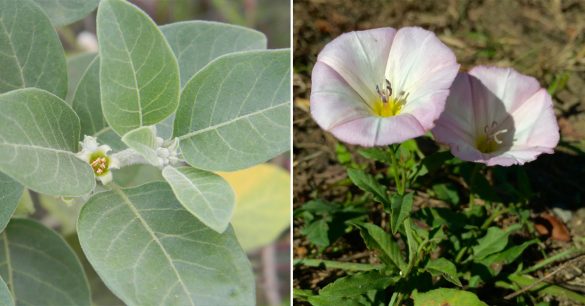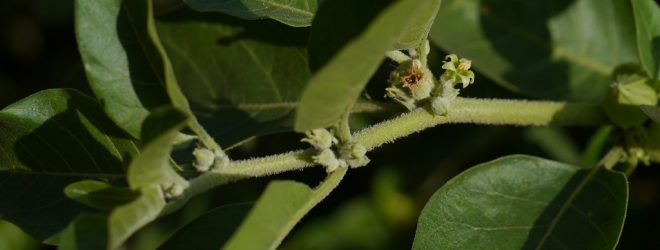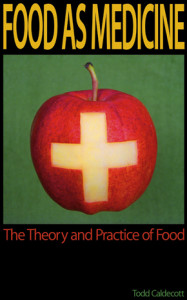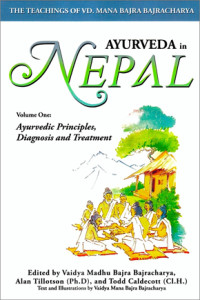As Ayurveda becomes increasingly popular in North America, it seems inevitable that many will become aware of some of its more important remedies. And among these various remedies the herb Ashwagandha has taken on a special prominence, such that many people are now making use of it. Let’s explore Ashwagandha: its various attributes, properties.
What is Ashwagandha?
First off, what is Ashwagandha? Well, in part this depends where you are in the world. The Sanskrit name “Ashwagandha” means “horse smell”, which rather than referring to the actual odour of a horse, refers to the power and potency that this herb is thought to imbue in one who takes it regularly. According to the nama-rupa-vigyana system of Ayurveda, names like Ashwagandha are somewhat interchangeable, and can be used for different species. A good example of this is the herb “Brahmi”, which denotes the property of “activating consciousness”, and can refer to either Bacopa monnieri or Centella asiatica. Likewise, the herb “Shankhapushpi” – which means “conch flower”, and is used like Brahmi to “enhance the intellect” (medhya), can refer to up to eight or more different plant species, including Clitoria terneata and Convolvulus pluricaulis. Mostly when we consider Ashwagandha, and especially that which is commonly found in the marketplace, it refers to the roots of Withania somnifera, a member of the Solanaceae or Nightshade family. It is an erect branching shrub that is covered in a woolly hairs, that thrives in the drier parts of India, West Asia and northern Africa, and is frequent roadside weed. This is why it’s important to make sure you get your Ashwagandha from a reputable and clean source. Not all of what we call Ashwagandha, however, refers to Withania somnifera. In the temperate mountainous regions of the Himalayas, where Withania doesn’t grow, local Ayurveda physicians use an entirely different and unrelated species for Ashwagandha, called Convolvulus arvensis. Also known as Field Bindweed, this plant grows in temperate regions all over the world: even in the US where it is considered to be a noxious weed. Although few are aware of its medicinal uses, in places such as Nepal, local physicians have extensively used this plant as Ashwagandha for millennia, and in my experience, Convolvulus is at least or even more powerful than Withania.

The Ashwagandhas: Withania somnifera (left), Convolvulus arvensis (right)
Ashwagandha benefits and uses
As I alluded previously, the name Ashwagandha refers to the virility of a stallion, and in this sense Ashwagandha is considered to be one of the premier sexual restoratives used by the branch of Ayurveda that is concerned with the treatment of infertility, called vajikarana rasayana tantra. Given this comparison Ashwagandha is more often thought of as a herb for men, used in the treatment of male sexual dysfunction. Clinical research on human subjects has validated this perspective, and in one study that examined the semen profiles and reproductive hormones in both normal and infertile men, it was shown that Ashwagandha improves sperm count and motility while significantly increasing serum testosterone levels. For problems with male sexual function, Ashwagandha can be combined with herbs such as Kapikacchu (Mucuna pruriens) and Gokshura (Tribulus terrestris). Ashwagandha can also be an important herb for women as well, used in combination with herbs such as Shatavari (Asparagus racemosus) in the treatment of infertility, threatened miscarriage, postpartum depression, and to enhance breast milk production. Unlike Chinese Ginseng (Panax ginseng), with which it is frequently compared, Ashwagandha can be safely used for both sexes, as well as in children, using other herbs in formulation to modify its medicinal properties.
Given the growth-enhancing, anabolic properties of Ashwagandha, it is an important herb to treat deficiency states, or an increase in vata dosha, characterized by exhaustion, weight loss, and poor immunity. When taken on a regular basis, both species of Ashwagandha enhance healthy weight gain, and along with regular exercise, helps to build and enhance muscle mass. In part this is due to Ashwagandha’s effect upon the nervous system, enhancing the activities of the rest and restorative systems, to conserve and build up the body’s energy by decreasing nervous irritability. In Ayurveda, Ashwagandha is described as a medhya rasayana, meaning that it rejuvenates the brain and nervous system. When prepared with milk and taken before bed, Ashwagandha is a remarkably effective and gentle sedative used in the treatment of chronic insomnia. In my clinical practice, I often use Ashwagandha for problems such as poor memory, lack of concentration and in the treatment of attention-deficit hyperactive disorder (ADHD), often in combination with herbs such as Brahmi (Bacopa monnieri) and Reishi (Ganoderma lucidum).
Ashwagandha is also useful in the treatment of inflammatory joint disease, which in Ayurveda is considered to be a vata disorder. For this purpose, it’s best to use Ashwagandha for pain and immobility, but not when there is active inflammation (characterized by redness, heat, and swelling). Ashwagandha also has use for breathing disorders including asthma and bronchitis. Another important use for Ashwagandha is to support the health of patients undergoing conventional cancer treatment, to protect against injury and infection, improve immune status, and enhance recovery. Likewise in HIV/AIDS patients, herbal combinations that contain Ashwagandha have been found to promote a significant decrease in viral loads and an increase in CD4+ counts. In my practice, I often use Ashwagandha in combination with herbs such as Licorice root (Glycyrrhiza glabra) to help wean patients off of corticosteroids.
Ashwagandha dose
One of the most common areas of confusion when using medicinal herbs is determining the correct dose, and this is often the case with Ashwagandha – both Withania somnifera and Convovulus arvensis. In part this confusion exists because most people are used to taking pharmaceutical drugs. Drugs are highly concentrated and powerful substances, used to suppress or inhibit some molecular mechanism of disease, and are often accompanied by a great variety of side-effects or are toxic in some way. For example, acetaminophen (e.g. tylenol) is the most common cause of liver damage in the US. Pharmaceutical drugs typically have what is called a very narrow therapeutic window, meaning that the target dose is pretty close to both a toxic dose and an ineffectual dose. In this way, every time a pharmaceutical drug is prescribed, it’s like trying to shoot an arrow through a narrow slit in the wall. In contrast, herbal medicines typically have a very large therapeutic window. This means that both low and high doses can be effective, but usually for different purposes. Of course, there are many herbs that have a small therapeutic window, such as a relative of Withania in the Nightshade family (Solanaceae) called Dhattura (Datura stramonium). But generally speaking, most herbs and especially nourishing herbs such as Ashwagandha are very safe, and have a large therapeutic window.
In herbal medicine we can say there are three basic dosage levels: high, medium, and low. A high dose is used for acute conditions, whereas a medium dose for chronic conditions, and a low dose for some kind of subtle, energetic effect, sometimes that opposes the original action of the herb. For example, the herb Lobelia (Lobelia inflata) will make you nauseated at a medium dose, vomit in large doses, but in very low doses, it can be very effective for nausea. The same is true for the Indian herb called Madanaphala (Randia dumetorum). Not all herbs are effective in very low doses, and this is often the case for nourishing, building herbs such as Ashwagandha.
The dosage ranges varies not just used for different purposes, but will be different depending on factors such as age and sex. In this way, a high dose for a child is not the same as a high dose for an adult. To calculate dose for children, use Clark’s Rule. In the case of Ashwagandha, a high dose for adults of up to 15-30 g of the powdered root can be used in cases of severe exhaustion, fatigue, nervous stress, and acute insomnia. High doses, however, are typically used only for a short period, under proper supervision, until the client has become stabilized. In such cases, Ashwagandha is best prepared in A2-milk, taken warm with a little ghee and jaggery, on an empty stomach.
A moderate adult dose for Ashwagandha, such as 2-5 g of the powdered root, is more effective for chronic conditions that tend to wax and wane, like chronic insomnia or chronic anxiety, or long term during recuperative periods. Once again, it’s the same ability of Ashwagandha to promote balance, but at lower doses so as to match the nature of the signs and symptoms. This is also a good dosage range when taken long term to harness the anabolic (brimhana) of Ashwagandha, helping with weight gain, or for its nootropic effects. At these doses the powdered root can also be prepared with A2-milk, or mixed with various anupana (‘vehicles’) such as water, ghee, or honey, depending on the effect desired.
Another way to take Ashwagandha would be as a fluid extract (prepared at a 1:1 ratio), or a tincture (prepared at a 1:3 ratio), with the dosage range between 2.5 mL (1/2 tsp) to 5 mL (1 tsp). Tinctures made at a 1:5 ratio will have to be dosed between 5-10 mL (1-2 tsp), and depending on the patient, this might seem like a lot of alcohol. Capsules are another option for taking Ashwagandha, but can be impractical at the higher end of the dosage range. More than 1-2 capsules is hard to swallow and not so great for weak digestion. It’s also important to note that encapsulated powdered herbs often have flowing agents added to them, like silicon dioxide, which is a micro-particle that can cause inflammatory symptoms in gut-sensitive people. For this reason, I tend to avoid capsules in my practice.
Lastly, another way to use Ashwagandha is to prepare it in your soup stock! Just throw a handful of the roots in a big stock pot along with all the other ingredients when making stock. Drinking the broth you make from all these ingredients is an easy and ideal way to optimize your nutrition.
Ashwagandha side effects and drug interactions
So now I have introduced you to Ashwagandha, describing what it is, it’s uses, and how to take it, and I want to end the article by making sure that you take it safely. I talked about the dangers of pharmaceuticals, and whenever a patient is taking such drugs, there is always a potential for side effects to occur. Drugs and herbs often have synergistic effects, but sometimes can have opposing effects, or when taken together, alter the way a drug is metabolized. Even grapefruit juice for example can induce the liver to speed up the metabolism of several drugs, such as statins and HIV protease inhibitors.
One of the reasons why Ashwagandha is so effective for nervous conditions is that it contains a variety of phytochemicals that synergistically promote a GABA-like activity in the brain. GABA is the central nervous system’s primary inhibitory neurotransmitter, and exerting this influence promotes a state of deep calm and relaxation. This is how some drugs such as sleeping pills work, but with much more powerful, and unfortunately, addictive effects. Given that Ashwagandha exerts an influence on GABA there is a potential interaction with many psychiatric drugs, from sleeping pills to anti-psychotics. This doesn’t mean that Ashwagandha can be helpful or used along with these drugs, but only under proper supervision
One interesting effect with Ashwagandha, is that like the Western herb Valerian, a small percentage of people (maybe 10-20%) will experience stimulatory effects after taking it. If these people take it before bed it will excite their nervous system and keep them awake all night long. There is no way unfortunately to know for sure who it will effect in this way, so be forewarned. Traditionally, it is considered to be a heating herb, and thus the perspective here is that people with a pitta constitution or those suffering from pitta issues (e.g. liver, heat, anger) may be more sensitive to its heating or excitatory properties.
Another class of drugs that Ashwagandha might interact with are steroids, such as corticosteroids or hormones. Like Licorice root (Glycyrrhiza glabra), Ashwagandha has useful anti-inflammatory properties, and I often use these two herbs to help slowly wean a patient off corticosteroids. Ashwagandha also has an androgenic activity, meaning that it could interfere with fertility treatments in women. This is why for women, it is usually mixed with Shatavari (Asparagus racemosa), which has estrogenic effects.
It has also been shown to have hypoglycemic (blood-sugar lowering) and hypolidemic (cholesterol-lowering) effects in clinical trials, and thus may enhance the activity of diabetes medications, or drugs used to treat heart disease. Rather than being an issue with the herb per se, this issue is caused by the drugs themselves, which have many interactions not just with Ashwagandha, but other herbs as well as every foods in the diet.
As I mentioned, Ashwagandha is regarded as a heating, warming herb, with nourishing and grounding properties. It is best used in people with a vata constitution or those suffering from vata issues. While it can also be used in formulation for kapha issues as well, due to its brimhana or anabolic effects, it tends to increase both kapha and the metabolic detritus of digestion called ama. Likewise, due to its heating effects, Ashwagandha may not be the best herb if there is active inflammation, or pitta. Note that when I say inflammation, I am not referring to it as a molecular mechanism, but as the cardinal signs of inflammation, i.e. heat, redness, swelling, and pain. A lot of what doctors call “inflammation” these days, such as arthritis, don’t actually exhibit these signs and symptoms of heat, and thus Ashwagandha remains an important herb for arthritis and many other supposed “inflammatory” disorders.
Ashwagandha quality
Like any herb, the effects you want from Ashwagandha are directly tied to the quality of the herb. Unfortunately, some of the Ashwagandha coming from India these days has been harvested from less than desirable locations, near raw sewage, industry, or urban pollution. As such, I always emphasize that you should know your source! It doesn’t necessarily have to be “certified organic” — but it should be ethically grown and harvested in a clean environment, ideally, by people that aren’t in it just for the money. Mother Earth provided us these herbs out of her love for us, and it is only right that the same respect is shown by those of us who harvest, grow, and use them.
The quality of your Ashwagandha is also dependent upon its freshness. While most people like to use the powdered herb, it has a shelf life of only 3-6 months. Thus if you buy a large amount of herb, store it in an air-tight container and keep it in the freezer. Encapsulated powders may have a longer shelf life, but this depends on how old the powder is that is being used to fill the capsules. The way things stand now in the industry, there is no way to know this when you buy a bottle of capsules, and the manufacturer expiry dates on the label are very often entirely arbitrary. For long term storage, it is better to keep your Ashwagandha in its whole root form, and only powder it as needed for a few months at a time. In their whole form, the roots can retain their potency for 2-3 years or more under optimal storage conditions. Another way to extend shelf life is to prepare it in alcohol as a fluid extract or a tincture, which typically have a shelf life of several years.







What is A2 milk and where would one get it?
How would one know or find out the quality of the ashwagandha they are obtaining? Can you recommend any sources?
You can’t get it yet in Canada, unless you find someone that has genetically tested their cows. Otherwise, sheep, goat or water buffalo milk are alternatives. You can, however, find A2 milk just across the border in the US. As for Ashwagandha, you need to research and ask questions about the supply. Locally, I suggest Sewanti (http://sewanti.com).
Hello, Todd! Do you know if ashwaganda increases estrogen or progesterone?
I am dealing with breast cancer, and have used ashwaganda daily for years.
Hi Kim – sorry for the delay. Ashwagandha should be safe for breast cancer. In this rat study, Ashwagandha was actually shown significantly reduce the rate of cell division in the mammary tumors. However, I wouldn’t rely on just this herb. For example, in my practice I might use formulas such as Chandraprabha vati and Kanchanara guggulu.
Hi Todd,
I just found you and really like your down to earth approach. I have avoided Ashwagandha because I’ve been healing an eczema condition for several years and I have known about it’s heating effect. I am glad to hear you mention this and not “pretend” that it is a miracle for everyone. My skin is much better and I am considering experimenting with this herb when the weather is cooler. Thanks again.
Hi Todd,
Is Ashwagandha safe in pregnancy?